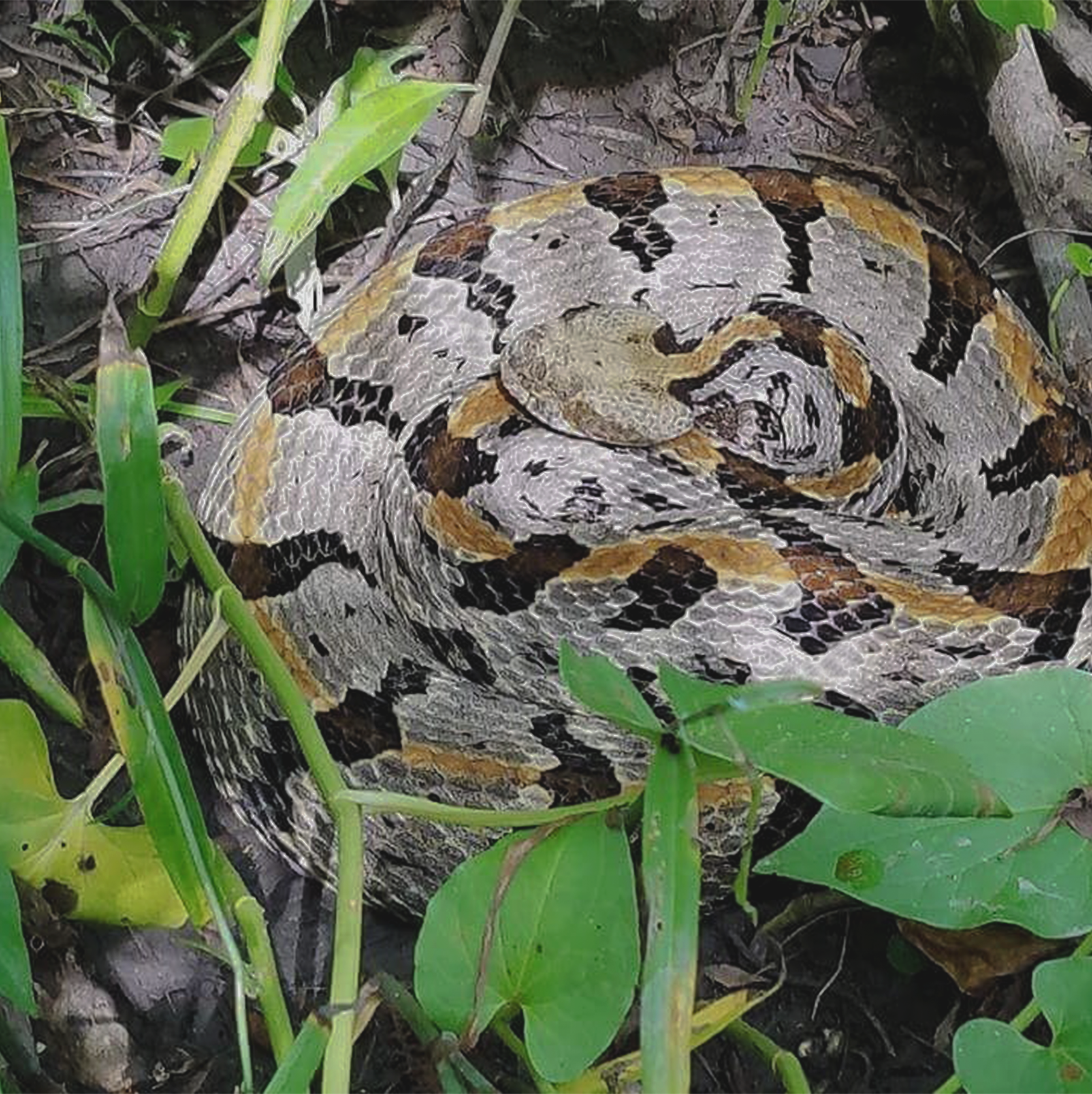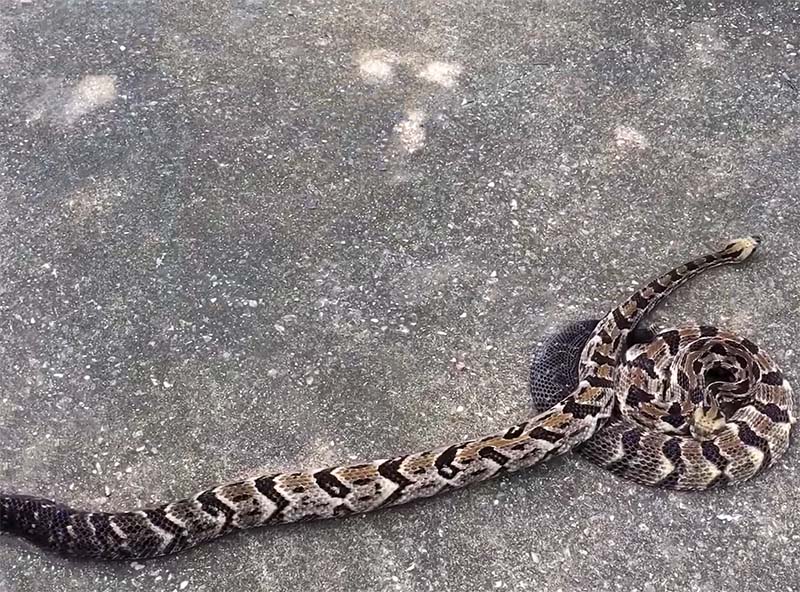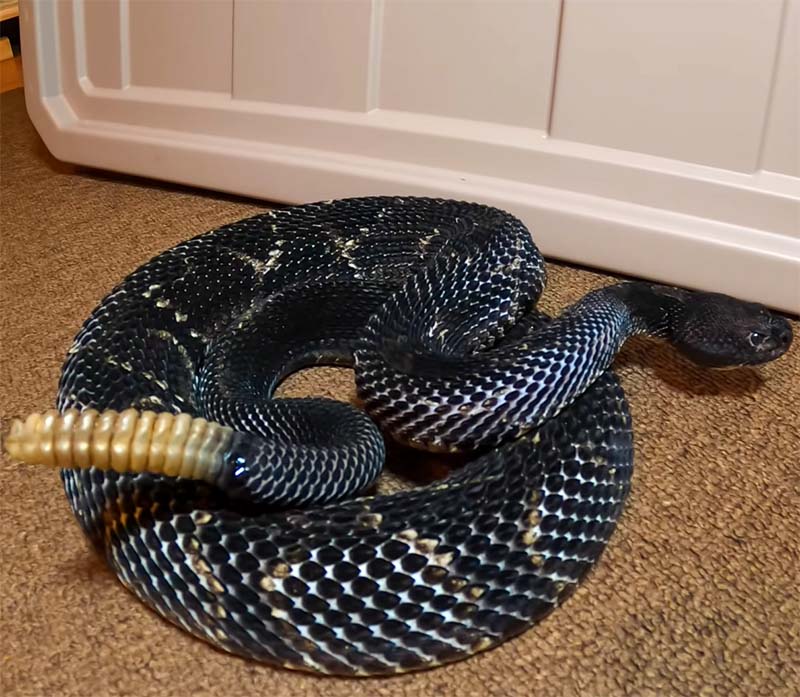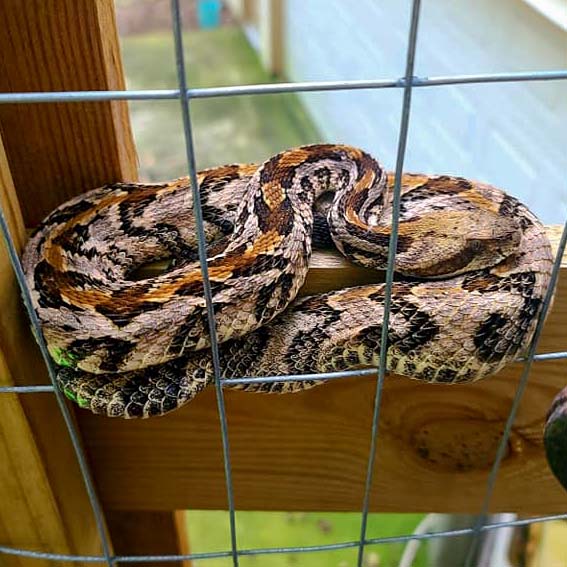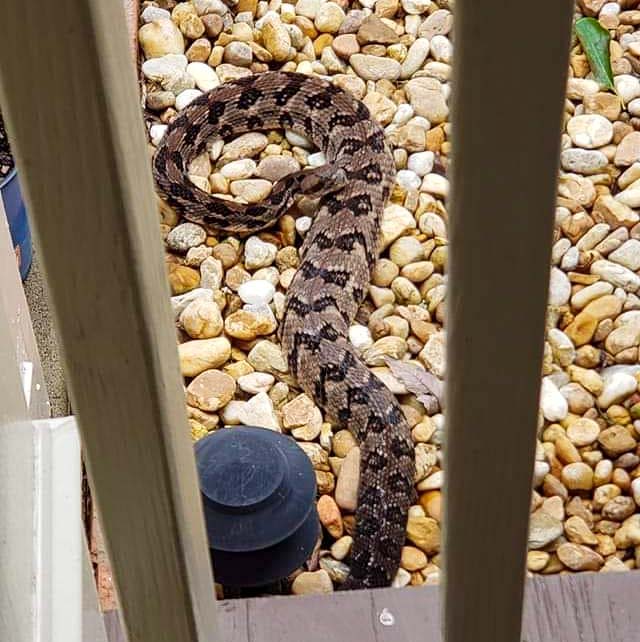
- Scientific Name
- Crotalus horridus
- Range
- Western Virginia in the Mountains
- Also Known As
- Canebrake, Banded Rattlesnake
- Venomous
- Yes
- Features
- Rattle on the Tail, Dark Bands on Body
- Prey
- Small Mammals, Birds, Frogs
- Litter Size
- 3 to 13 per Birth
- Life Span
- 10-20 Years
- Length
- 2.5 - 4 Feet
Quick Links
Timber Rattlesnake Description
Timber Rattlesnake Appearance
Timber Rattlesnakes here in Virginia can vary in color. The colors could be yellow, brown, tan or gray. Timber Rattlesnakes have a distinctive stripe down their back the colors can be orange, yellow, pink, brown, or black. What makes them distinct is their rattlers which they use to warn unsuspecting animals and people that get too close.
The rattlers are made of keratin, which is the same material as your fingernails and hair. Juvenile Timber Rattlesnakes have a singe rattle on their tail which will grow after each time it sheds.
Timber Rattlesnakes are venomous, in fact their venom is the most deadly of all the snakes in Virginia. However, Timber Rattlesnakes are quite shy and will prefer to warn or run away unless deliberately provoked.
Size
The normal length for Timber Rattlesnakes is between 30 and 60 feet long. The record for the largest Timber Rattlesnake was more than 6 feet long! These snakes tend to be heavy bodied and are never thin.
Myth: Baby Rattlesnakes Are More Dangerous
False:
Timber Rattlesnakes do not release more venom than adults. In fact, they tend to be less dangerous as they have less venom than adults. This is not true for the Copperhead Snake here in Virginia. However, they can be more trouble than the adults due to their small size, making spotting them much harder. They may even be too young to even have a rattler, so watch your step!
Identifying a Timber Rattlesnake
Timber Rattlesnakes are easy to identify here in Virginia, as it is the only rattlesnake that appears here in Virginia. As such the Timber Rattlesnake has their distinct rattle at the end of their tail. But here are ways to identify the rattler without the rattle.
Pattern and Color
Timber Rattlesnakes can be dark brown, yellow, black or even pinkish with dark bands across their body. They are in a zig-zag pattern with the number of points varying wildly.
Some of the bands do not go across the entire back and stop before it reaches the spine.
It should be known that there are 3 different types of Timber Rattlesnake that are based on their geography.
Yellow Phase
These have a yellowish body, with dark brown to black blotches and bands.
Canebrake Phase
Same as yellow phase but the body tends to be lighter with a brownish stripe down the back
Black Phase
The body is black or a very dark color, making the bands hard to spot. Rarely the snake can be all black with the bands being missing or hidden.
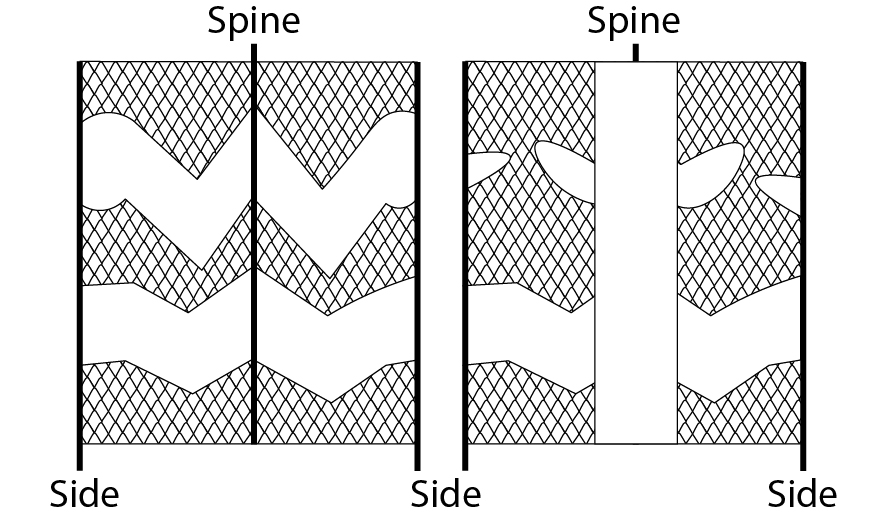
Left: Yellow and Black Phase Variant
Right: Canebrake Variant
Timber Rattlesnake Behavior
Timber Rattlesnakes are actually one of the more docile snakes in the rattler family. These snakes will only bite as a last resort, and will only strike if cornered, and prefers to hide rather than attack.
These snakes if agitated will use its rattler to warn approaching animals and humans, if you get too close.
These snakes are active throughout the day and night, but spend most of their time coiled and resting waiting for prey to come to them.
During the winter, timber rattlesnakes will brumate (light hibernation) between October to Late April or Early May. These snakes prefer to hide in crevices on cliff sides or on the ground
Timber Rattlesnake Range and Habitat
Range
Timber Rattlesnakes tend to be in the mountainous wooded areas of Western Virginia. The Timber Rattlers that are outside of the mountainous regions are called Canebrakes, which can be found in South Eastern Virginia.
Habitat
Timber Rattlesnakes prefer mountainous wooded areas, and like to live near ledges facing the sun so they can be safe and bask in that sunny goodness. Canebrakes tend to prefer cane fields, ridges, and glades of the swamp and areas surround it.
Diet
Timber Rattlesnakes tend to eat small mammals such as mice, squirrels, shrews etc. While not as common, they also eat birds, lizards, and frogs.
Timber rattlesnakes are ambush predators. Which means that they capture prey by hiding and waiting patiently, then they strike with their venom when the prey gets near.
Timber Rattlesnake Reproduction and Young
Reproduction
Timber Rattlesnakes mate from early summer to late fall. Male Timber Rattlers will compete for females and will dance to woo her. Once the female is pregnant she will move to more open habitats while the males will hide in areas with more cover
Eggs and Young
Timber Rattlesnakes give birth in the late August or early September from 3 to 13 babies. They do not lay eggs, so if you find any eggs on your property be at ease that they are not Timber Rattlesnakes. This is because they are viviparous which means that the eggs are hatched in the body of the mother. Young Timber Rattlesnakes has one rattle called a button, which they will gain more with each new shed.
Myth: The More Rattles It Has the Older the Snake
Mostly True:
It is true that Timber Rattlers gain a new rattle with each shed, however, after a while, they will lose a rattle and gain one with each shed. Due to this, there tends to be a maximum limit of rattles in Timber Rattlesnake. Due to this, because one timber rattlesnake has one more rattle, does not mean that it is older than the other.
Timber Rattlesnake Venom and Danger
Venom Effects
Timber Rattlesnake venom will lead to death you must go to the hospital immediately if bit.
Timber Rattlesnake venom will lead to these symptoms:
- Rapid redness/Swelling around the bite
- Extreme Debilitating Pain
- Increased Heart rate
- Getting hard to breathe
- Numbness or tingling around the mouth, tongue, scalp, feet, or the bite area.
- Increase of Salivation and Perspiration
- Numbness of limbs and face
- Having signs of Shock
- Passing out (losing consciousness).
- Feeling very dizzy or lightheaded, like you may pass out.
- Slow thinking and not being alert. You may be confused, restless, fearful, or unable to respond to questions.
- Feeling weak or having trouble standing
If You Have Been Bitten by a Timber Rattlesnake
- Stay Calm an increased heart-rate will pump your blood faster which will make the venom spread throughout the body faster.
- Take a Photo or Video of the Snake this will lead dispatch to know what snake has bit you which will help get the right antivenin to you. If you can’t write down or make a note of the size, color, and patterns of the snake
- Dial 911. Do Not Drive Yourself to the Hospital Dizziness and passing out is a very common symptom from snake bites.
- Lay or Sit down. Be Comfortable
- Keep Bite Below Heart This will make the venom fight gravity to reach your heart.
- Remove Rings and Watches The swelling from the bite can cause swelling, which can lead to circulatory issues from watches and rings
Myth: Cutting and Sucking Out the Venom Helps Snake Bites
False:
Sucking the venom out of a bite is a futile effort, as by the time that you get to it a lot of the venom would be already spread out. Plus cutting and sucking will lead to an infection, which will make it more likely for the bite to be fatal.
